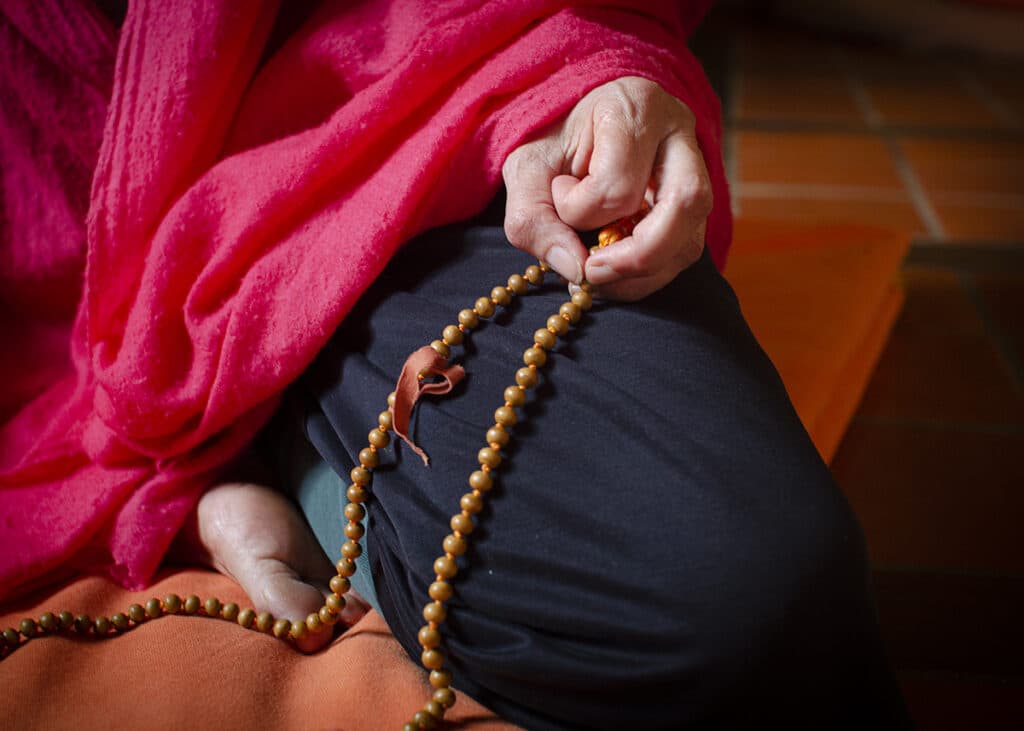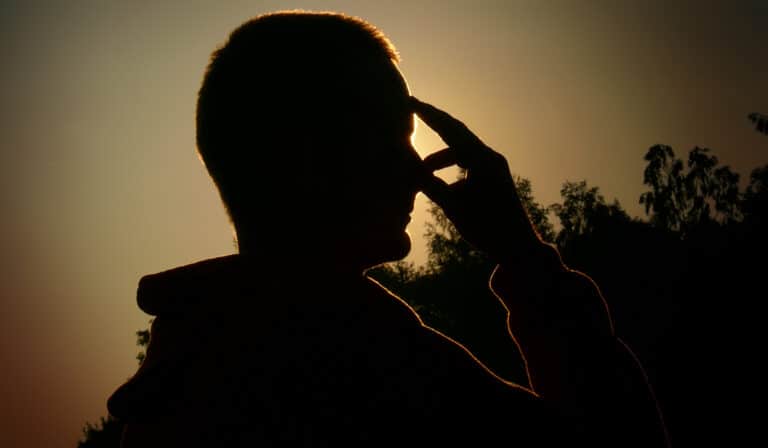Ajapa Japa is a meditation technique specific to Satyananda yoga. It combines ujjayi pranayama, awareness of pranic channels and chakras with the mantra Soham. Swami Satyananda’s Ajapa Japa comes in different forms. There are versions suitable to beginners and practices that are better for confirmed practitioners.
The origins of Satyananda’s Ajapa Japa
Swami Satyananda was a 20th-century yoga master that revived a host of ancient yogic practics. He created a comprehensive system of yoga techniques that today is called Satyananda Yoga. One critical method in his approach is the Ajapa Japa meditation.
Japa is a generic term for mantra repetition. The letter “A” in front of the word japa means “without”. Thus Ajapa Japa translates as “non-repeated mantra repetition”. That is a repetition that is effortless and spontaneous. It just happens.
Ajapa japa is an ancient concept. However, the way that Satyananda combines his Ajapa Japa with ujjayi pranayama and pranic flows is unique. It appears to be a creative invention in line with his other contributions to modern yoga.
Satyananda Ajapa Japa displays influences from hatha yoga and striking similarities with the first kriya in Lahiri Mahasayans Kriya Yoga system. In the Satyananda system of yoga as well, there is an overlap between Ajapa Japa and Kriya Yoga.
Soham mantra
In Satyananda Yoga, the Soham mantra is considered the mantra of the breath. Soham means “I am that”. Repeating it implies that one seeks to identify oneself with the universal consciousness.
The Soham mantra is what Swami Satyananda recommends for his Ajapa Japa meditation. However, he has said that any mantra that you can divide into two syllables (like So-Ham) can be used. Typically that would be of interest if you already have a personal mantra.
Psychic passages
There are two main energy channels (nadis) that are involved in Satyananda Ajapa Japa. The first is the primary channel in the front part of the body. This passage goes through the chakra kshetrams. The chakra kshetrams are the energy points in the torso’s frontal part that resonate with the chakras in the spine. Many people find it easier to feel energy vibrations here than in the chakras themselves.
The second channel is the Sushumna nadi. Sushumna traverses the chakras between Muladhara above the perineum and Ajna chakra in the middle of the head. It is the most crucial energy passage in yoga. In addition, for advanced practice, you can combine these two passages to form a circuit. That is the case in Satyananda Kriya Yoga.
Ujjayi pranayama
You do Satyanandas Ajapa Japa together with the ujjayi breath. This pranayama has many names, and yogis call it the psychic breath, the ocean breath or kundalini pranayama.
To do ujjayi, you breathe with a slight whisper. You also pause the breath briefly after in- and out-breath. This technique allows you to slow down your breathing and make it more profound, regular, and smooth. The ideal rhythm for Ajapa Japa is 90 breaths per hour. Ujjayi has an immediate impact on your nervous system, your mental state and your energy. Thanks to this breath, you can quickly bring yourself into a meditative state.
The meditative state you enter with the psychic breath induces deep healing and releases energy bound by psychic tensions. That is why this pranayama has an energizing and empowering effect.
When you do ujjayi pranayama, you keep your tongue in khecari mudra. Swami Satyananda recommended what he called the raja yoga version of khecari. To do that, you fold your tongue backwards and place its tip on the soft part of the pallet. For a more significant effect, advanced practitioners can insert the tongue into the nasal pharynx.
Frontal passage meditation
Swami Janakananda is one of Satyanandas most prominent disciples. When he learnt the frontal passage Ajapa Japa in the late 1960s, Swami Satyananda called it the Vishuddi Shuddhi meditation. That translates to the practice that purifies the Vishuddhi chakra. Janakananda kept that name, but in addition, he also called it the Source of Energy meditation. The Vishuddi Shuddi that Swami Janakananda teaches is a five-step practice that takes 30-45 minutes. You can learn this Ajapa Japa version online here on Forceful Tranquility.
Full Ajapa Japa
You will find a description of the Ajapa Japa meditation in Swami Satyananda’s book Tantric Meditations. However, keep in mind that Swami Satyananda’s books, for a large part, were written by his followers rather than himself. The Ajapa Japa version in Tantric Meditations is not the one Swami Janakananda learnt when he was with Satyananda. At that time, Satyananda taught full spinal Aapa Japa as a nine-step sequence.
The nine-step Ajapa Japa includes the following steps:
- Om
- Air
- Soham
- Hamso
- Shakti Chalini
- Equilibrium
- Flower
- Dimensions of the inner space
- Psychic symbol
The above Ajapa Japa sequence takes between one hour and twenty minutes and two hours to complete depending on how slow your breath is. During steps one to four, you use a mala to track when to pass from one practice to another. A mala is a meditation rosary with a hundred and eight beads.

You hold the mala in your hand during the meditation, and after each breath, you move one bead forward. You tie cloth strings to the mala to divide it into sections that each represent a different practice. When you arrive at a cloth mark, you know it is time to move to the following method.

How to set up your mala for Ajapa Japa
When I learned Ajapa Japa from Swami Janakananda, he had us do the full mala. That is 108 breaths. For a deep and calm practice, that is a perfect length. However, Janakananda said that when he learnt it from Satyananda in the 1960s, they would turn the mala around once at the last bead and continue for another 49 breaths. That makes it a very long and challenging practice for most.
For daily practice, you might find that the full mala takes a too long time. Then you can shorten your mala. Just bear in mind that a shorter mala means that you will not go as deep with your practice.
Mala configurations
- 11 + 33 + 32 + 32 Full lenth
- 13 + 46 + 49 + 49 Extended
- 11 + 22 + 22 + 22 Short
- 11 + 11 + 11 + 11 Super short
How to learn Ajapa Japa
To benefit even from the primary Ajapa Japa meditation, you need to be comfortable with several basic yoga methods. That is why Ajapa Japa meditation is best learnt and practised with other yoga techniques, just like I do here on Forceful Tranquility. I integrate the frontal passage Ajapa Japa (the Source of Energy meditation) in yoga sessions that last more than two hours and fifteen minutes. I place tthe Source of Energy meditation at the end of the sessions when you are the most receptive to it.
The Source of Energy meditation is the best choice for most people. The nine-step spinal Ajapa Japa is more demanding to learn and practice. It is suited for motivated yoga adepts who find it easy to practice it daily.
I only teach the nine-step spinal Ajapa Japa under special conditions and only to confirmed yogis. There are two reasons for that. Firstly unless you have excellent learning conditions, you won’t experience the depth that this meditation has. The practice will be mechanical and shallow. Secondly, it is about safety. Unless you are ready for Ajapa Japa, you might experience irritability, restlessness and a disturbed mental state if you do it too much.
I teach full Ajapa Japa in the two following ways:
14-day yoga retreats
Two-week yoga retreats with more than seven hours of yoga and meditation per day is a good setting for initiation into the big Ajapa Japa. During the first part of the retreat, the participants work to make themselves receptive. In the end, I teach the most subtle practices during a silent period.
Consecutive weekend courses
The other way I teach the big Ajapa Japa is during weekend intensives. The sessions take place four weekends in a row. They take place Saturday and Sunday morning and last five hours. Before getting to the meditation, the course participants go through a complete asana, pranayama and yoga nidra programme. Participants, in addition, need to practice for two hours every day during the week.
Benefits of Ajapa Japa meditation
The Ajapa Japa meditation is empowering. It increases your mental stamina and endurance, making you capable of achieving more in life. It helps you overcome mental resistance. Objections and hesitations that usually would limit you can’t hold you back anymore. You find yourself getting things done effortlessly.
Furthermore, you build up a strong energy field. That means that you won’t easily get influenced by other peoples states. You can be around sad or depressed people without absorbing their vibrations.
Another benefit of this meditation is that it brings suppressed memories and unconscious thought processes up to the conscious areas of your mind. Satyananda Ajapa Japa is also healing. The deep rest you get during is enhancing the body’s natural healing processes.
How to get good results and avoid side effects
There are three requirements to getting good results.
The first requirement is to combine Ajapa Japa with other techniques, asana (yoga poses), awareness-based meditation (such as antar mauna), pranayama (breathing exercises) and yoga nidra.
The second requirement is that you practice regularly. The longer your practice sessions are, the more crucial regularity becomes. Practising every day is ideal.
The third requirement is that you balance this meditation with an active life.
Key takeaways
- The Ajapa Japa meditation is a crucial practice specific to the yoga of Swami Satyananda.
- To appreciate Ajapa Japa fully, you need to combine it with other yoga methods.
- To explore advanced Ajapa Japa in-depth, you need special conditions and a programme that builds concentration and makes you receptive.




